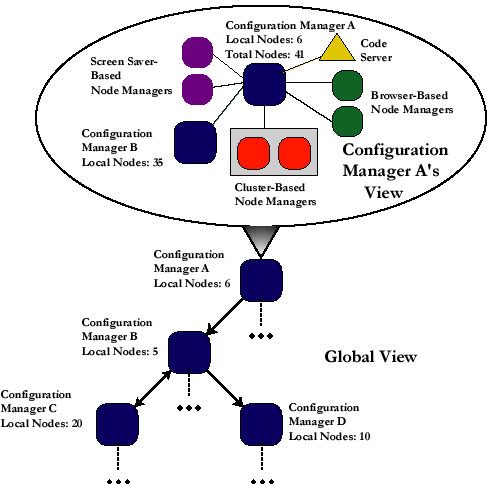DOGMA
<Pending: Include an overall paper describing DOGMA>
<Pending: This paper describes 1.0 functionality. Possibly
change for 0.9>
Introduction
DOGMA allows parallel applications to be developed and executed in a straightforward
manner. Utilizing the Java platform, DOGMA allows non-technical users
to run parallel applications without the need to install any software on
their local machine. In addition, DOGMA allows application developers
to publish parallel executable code on a webserver where it can then be
executed by users anywhere in the world.

Figure 1: DOGMA Architecture
Architecture
DOGMA has a decentralized architecture divided into units known as "configurations".
Each configuration is managed by a "configuration manager" which is capable
of linking to other configuration managers in a hierarchical fashion. Configuration
managers may optionally allow other configuration managers to join them
and use their local resources. For instance in Figure 1 configuration
manager A can utilize the resources of B but the reverse is not true as
indicated by the unidirectional arrow. However, configuration manager
B and C can both utilize each other's resources as indicated by the bi-directional
arrow. Configuration managers periodically exchange information such
as total number of nodes and total number of nodes. This information
then propagates through the hierarchy.
As an example, consider Figure 1. An arrow from one configuration
manager to another indicates that the source configuration manager may
run remote jobs on the destination configuration manager. Note that
configuration managers never see the global view. So from configuration
manager A's point of view there is only one configuration manager attached
to it, but this configuration manager has 35 nodes which is the sum of
all nodes downstream in the configuration graph.
Within each configuration three types of nodes may contact the configuration
manager to join the system:
-
Dedicated nodes - these nodes have access to DOGMA source code and are
launched from the configuration manager's system console.
-
Browser-based nodes - these nodes join the system by "browsing in" to a
specific web-page served by the configuration manager.
-
Screen-saver based nodes - these are nodes which have the DOGMA screen
saver installed on them, and join the system automatically when they are
idle.
Also within each configuration are "code servers" which are http servers
used to distribute binary code for a given set of applications; they allow
DOGMA to function with no shared file system. Optionally, "data servers"
may be added to the configuration to serve application data files.
When nodes join a configuration they sign a "contract" with the configuration
manager informing the configuration manager of the duration for which they
will stay in the system. This prevents the configuration manager
from scheduling long running jobs on transitory nodes. Nodes also
inform the configuration manager of certain attributes such as processing
power.
To improve application performance and enhance usability, applications
have an associated definition file which informs DOGMA of the application's
system requirements and startup arguments. Application requirements
may consist of the number of nodes, processing power required, networking
connection required, whether or not the application allows a varying number
of nodes, how long the application expects to run, etc.. Startup
arguments free the user from the need to remember which arguments are required
by which application, and can be simple text entries, a list of choices,
etc..
When an application is run, the system attempts to match the application
with a set of nodes which meet the application's requirements. If
it cannot find a set of nodes locally, it may (depending on the application
requirements) look remotely for nodes to run the application on.
The information exchanged periodically by configuration managers helps
them make intelligent decisions about where to remotely run a job.
DOGMA Programming APIs
DOGMA is programmed using one of two programming APIs: MPIJ or Dynamic
Object Groups. MPIJ is DOGMA's implementation of the MPI standard
(we are working with other members of the Java Grande Forum on a formal
proposal for MPI-like bindings). Dynamic Object Groups allow hierarchical
master/slave style programs to be written in a very simple fashion which
can scale to large numbers of nodes where the number of nodes is allowed
to vary at runtime.

